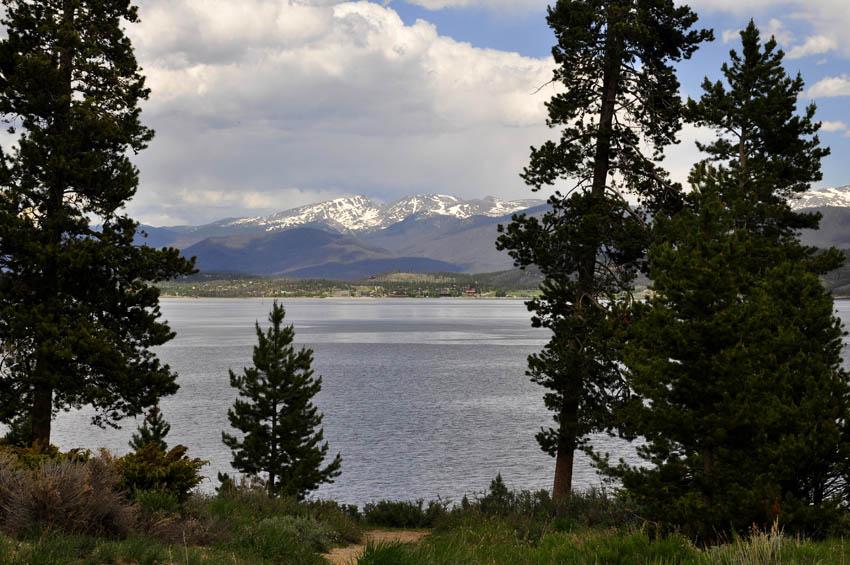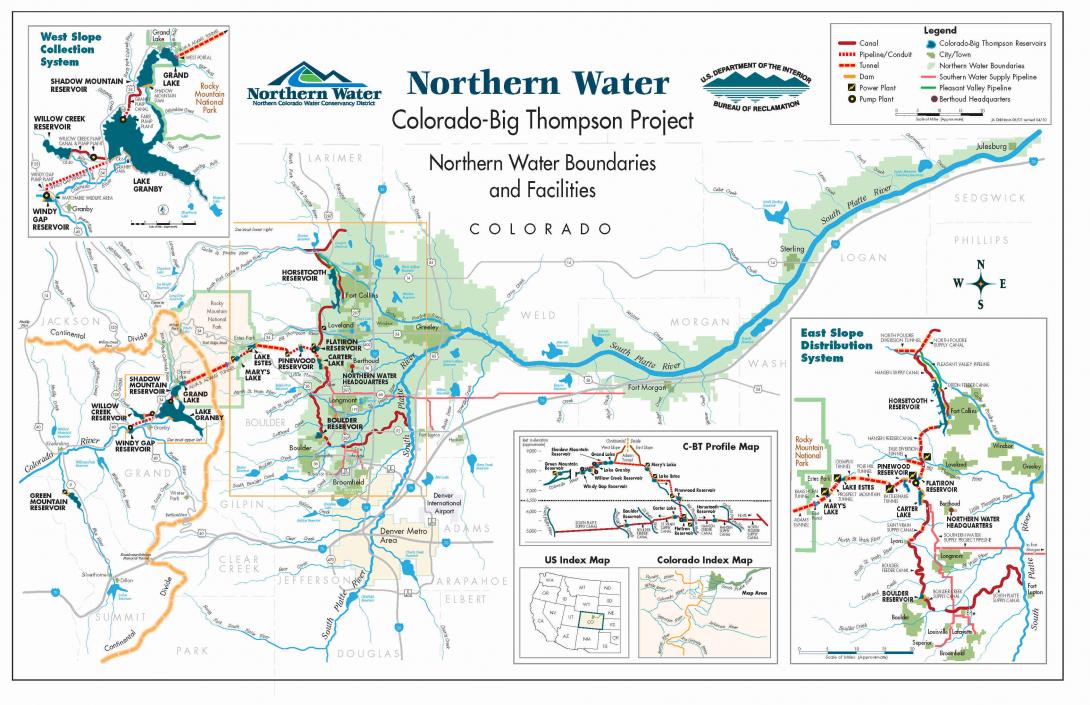Colorado–Big Thompson Project
Full Article
The Colorado–Big Thompson Project (C–BT) is the largest transmountain water diversion in the state of Colorado. Built between 1938 and 1956, the C–BT Project provides supplemental water for municipal, industrial, and irrigation purposes in northeastern Colorado. Water from the C–BT Project also helps irrigate nearly 650,000 acres of farmland in parts of eight Colorado counties.
The C–BT Project consists of a complex system of reservoirs, pump plants, tunnels, pipelines, and power plants. The project accumulates melting snow in the upper Colorado River basin and delivers the water to Colorado's Eastern Slope via a tunnel beneath the Continental Divide. Annually, C–BT collects and delivers approximately 215,000 acre-feet of water—roughly equivalent to the average annual flow of the Cache la Poudre River.
Seven C–BT Project hydropower plants together generate an average of 770 million kilowatt hours of renewable energy per year. The C–BT system spans nearly 10,000 square miles and includes 12 reservoirs, 35 miles of tunnels, 95 miles of canals, and 700 miles of transmission lines.
Transmountain Water Diversion
The prevailing westerly winds of the northern hemisphere’s mid latitudes dictate that approximately 80 percent of Colorado’s precipitation occurs west of the Continental Divide, largely as winter snowfall. Yet, more than 80 percent of the state’s population, as well as a large majority of its irrigated agriculture, are located east of the divide.
Colorado’s early transmountain water diversions in the nineteenth century were small, crude ditches that collected high-altitude snowmelt and diverted it by gravity through mountain passes from one watershed to another, typically for agricultural purposes. A good example is the Grand River Ditch, which diverts water from the Upper Colorado River basin to the South Fork of the Cache la Poudre River via La Poudre Pass. These early transmountain water diversions helped develop the agricultural economy of the South Platte River basin.
Northern Water
In the twentieth century the Northern Colorado Water Conservancy District (also known as Northern Water) and others began to divert water on a much larger scale. Northern Water is a public agency created under authority of the Colorado Legislature’s 1937 Conservancy District Act. It was initially responsible for contracting with the federal government to build the C–BT Project. The total cost for the project was approximately $164 million when completed in 1956. Northern Water repaid its $25 million portion of the total project cost between 1962 and 2002. The remaining balance was covered by hydropower revenues.
Northern Water and the US Bureau of Reclamation jointly operate and maintain the C–BT Project, which is owned by the federal government. In addition, Northern Water also gathers, distributes, and monitors water quality and weather data, tracks stream flows and reservoir levels, and provides water resource planning and water conservation information services.
Western Slope Water Collection
The C–BT Project’s Western Slope collection system accumulates and stores upper Colorado River basin water before transporting it to the Eastern Slope. The collection system consists of three reservoirs, a natural lake, multiple canals, and two pump plants.
Collection system reservoirs include Lake Granby, the C–BT Project’s largest water body, Willow Creek Reservoir, and Shadow Mountain Reservoir. The two pump plants—Farr and Willow Creek—send the collected water upslope before it enters a tunnel and flows beneath the Continental Divide to the Eastern Slope.
Water from the C–BT Project is delivered to Colorado’s Eastern Slope and Eastern Plains through the Alva B. Adams Tunnel. The tunnel extends a little over thirteen miles eastward from its West Portal on Grand Lake to the East Portal southwest of Estes Park. The entire length of the tunnel lies beneath Rocky Mountain National Park.
The linchpin of the C–BT Project, the Adams Tunnel is nearly ten feet in diameter, concrete-lined, and cuts through the Continental Divide as much as 3,800 feet beneath the earth’s surface. The tunnel drops 109 feet in elevation between the West and East portals, enabling water to flow by gravity without pumping assistance. It takes water about two hours to travel the length of the tunnel.
Eastern Slope Water Distribution
Once C–BT Project water exits the Adams Tunnel at its East Portal, it passes through a distribution system of canals, pipelines, small reservoirs, and six hydroelectric power plants. The water is stored in three terminal reservoirs: Horsetooth, Boulder, and Carter Lake. From there, C–BT water is delivered to cities, towns, industries, and farms.
Nearly 900,000 people live within Northern Water boundaries, which encompass 1.6 million acres in portions of eight counties: Boulder, Broomfield, Larimer, Logan, Morgan, Sedgwick, Washington, and Weld. Between April and October, the primary growing season, Northern Water also delivers water to more than 120 ditch, reservoir, and irrigation companies serving thousands of farms and more than 640,000 irrigated acres.
Power Generation
The C–BT Project’s seven hydropower plants generate approximately 770 million kilowatt hours of energy per year. The C–BT Project’s two Western Slope pump plants annually use 70 million kilowatt hours. The remaining 700 million kilowatt hours are sold to customers in Colorado, eastern Wyoming, and western Nebraska.
Power is generated by water flowing through power plant turbines to produce hydroelectricity. The power sold to customers is enough to supply approximately 68,000 homes for a year. Six of the hydropower plants are located on the Eastern Slope. The project’s only Western Slope power plant is located at Green Mountain Reservoir on the Blue River near Kremmling. The six Eastern Slope power plants also supply power for peak demands using a system of forebays, afterbays, and penstocks.
An eighth C–BT Project hydropower plant is currently under construction on the Western Slope below Lake Granby Dam on the Colorado River. It should be completed and operational by late 2016.
Today
Today, multiple transmountain water diversions operate in Colorado to bring much-needed Western Slope water to the Eastern Slope for municipal, industrial, and agricultural purposes. In terms of volume, the C–BT Project is the largest of the state’s transmountain water diversions. Without it, northeastern Colorado would be a much drier place today.




























